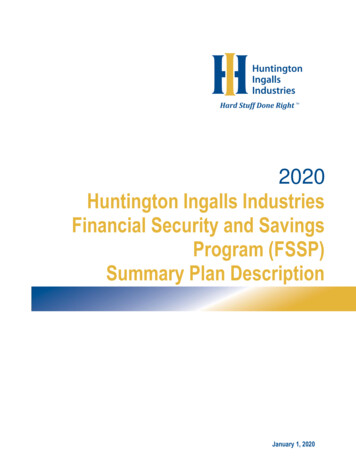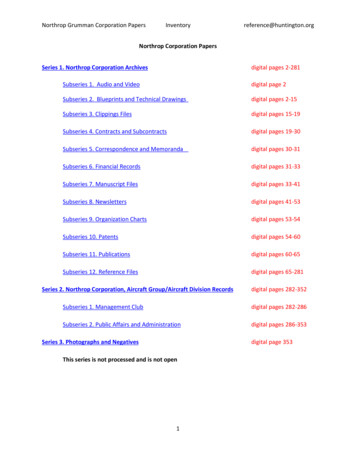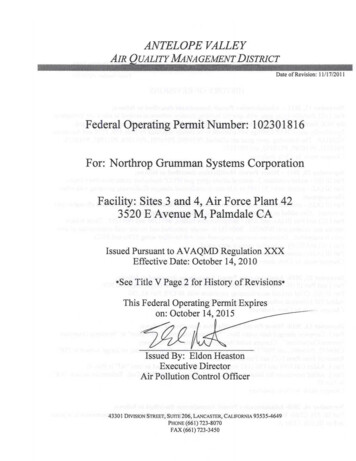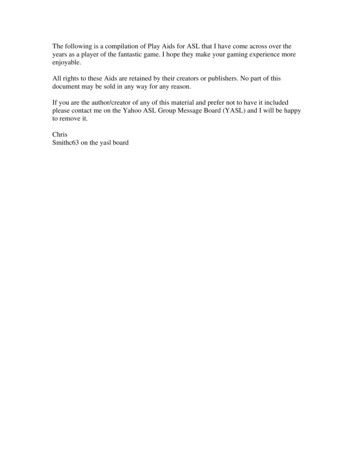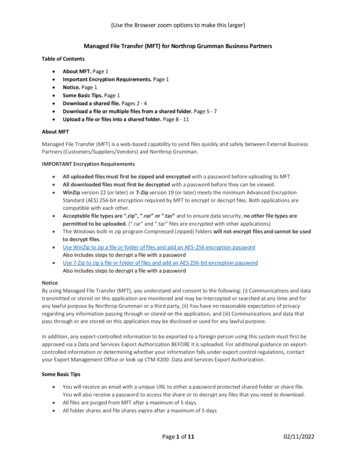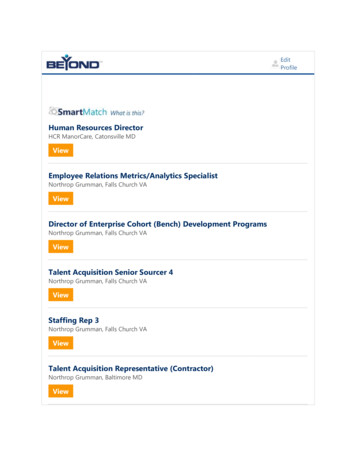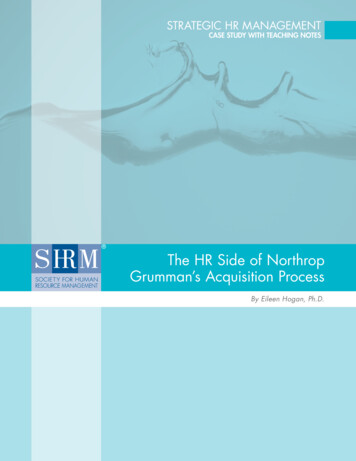
Transcription
Strategic HR Managementcase study with teaching notesThe HR Side of NorthropGrumman’s Acquisition ProcessBy Eileen Hogan, Ph.D.
Project TeamAuthor:Eileen Hogan, Ph.D.SHRM project contributor:Nancy A. Woolever, SPHRExternal contributor:Michele TothCopy editing:Katya Scanlan, copy editorDesign:Blair Wright, senior graphic designer 2009 Society for Human Resource Management. Eileen Hogan, Ph.D.Development of this case was made possible by a grant from the Society for Human Resource Managementand the National Academy of Human Resources. The characters in the case are real, and their quotations areverbatim. Information presented was current as of the time the case was written. Any errors are solely theauthor’s.Note to HR faculty and instructors: SHRM cases and modules are intended for use in HR classrooms atuniversities. Teaching notes are included with each. While our current intent is to make the materials availablewithout charge, we reserve the right to impose charges should we deem it necessary to support the program. However,currently, these resources are available free of charge to all. Please duplicate only the number of copies needed,one for each student in the class.For more information, please contact:SHRM Academic Initiatives1800 Duke Street, Alexandria, VA 22314, USAPhone: 1-800-283-7476 Fax: 1-703-535-6432Web: www.shrm.org/education/hreducation09-0737
Teaching NotesThis case deals with the process that Northrop Grumman Corporation (NGC) usesto integrate the human resource aspects of its acquisitions. The process has evolvedover the past 17 years, when NGC started acquiring firms to support its corporatestrategy. The case discusses the steps NGC goes through in integrating various HRsystems, as well as the team approach that NGC uses.In addition to dealing with the integration of HR systems, the case reveals NGC’scorporate culture and how it attempts to integrate its new acquisitions, both big andsmall, into its operations. Much of NGC’s culture can be seen through how its ownmembers talk about its operations.Uses of the CaseThis case could be used in an upper-level undergraduate course, a graduate courseor an executive MBA course in strategic HR, HR compensation and benefits ormanagement of mergers and acquisitions.Learning ObjectivesBy the end of the case discussion, students should be able to:1. Describe the complexity of acquisition evaluation and integration.2. Discuss choices that an organization makes in how it manages the acquisitionprocess in terms of teams, speed and post-acquisition integration.3. Explain how organizational cultures affect acquisitions.4. Examine how an organization’s strategy can be supported by HR practices.5. Discuss mergers and acquisitions as a possible piece of an organization’s strategy. 2009 Society for Human Resource Management. Eileen Hogan, Ph.D. 1
Possible Discussion Questions1. W hat is the most important lesson(s) that NGC thinks it has learned about evaluating andintegrating acquisitions well?nnStudents may have a variety of answers to this question, such as: The importance of strategic fit (p. 13). Not pursuing hostile targets (pp. 13-14). The due diligence process (p. 13 ). Use of teams (pp. 14-15). Team leadership (p. 15). Steps in the process (p. 16). Managing data and communication virtually (p. 16). Development and use of checklists (p. 17). Retention of key individuals (pp. 19-20). Length of retention agreements (p. 20). Flexibility of structure (pp. 22-23). Implementation planning and execution (p. 25-27).nnHowever, the two most important are arguably: Culture fit (pp. 28-31). Involvement of HR in due diligence process (pp. 15-16, 23-24).2. How successful is NGC, really, at managing MAs? How do you measure success?nnnnFinancial performance is shown in Table 2. tudents may have a variety of other suggestions for appropriate measures, such as success inSintegrating people and managing cultural issues of acquisitions.3. Describe the NGC culture. Is it changing? Is that a good thing or a bad thing?nnnnOn pages 28-29, this topic is discussed from the employee standpoint.Generally, larger organizations become more bureaucratic, policy- and procedure-driven andconservative.4. Would you care to work in a culture like NGC’s? Why? How does NGC’s culture compare withthe company you presently work for?5. For the most part, small acquisitions that NGC makes are brought in and culturally integratedinto NGC. Is this wise? Should NGC keep acquisitions more independent?2 2009 Society for Human Resource Management. Eileen Hogan, Ph.D.
nnnnThis is discussed on pages 23 and 30.Students should be able to argue the pros and cons of complete integrationversus allowing independence.6. How sensitive is NGC to cultural issues in acquisitions? Should it be more or lesstolerant of cultural variations?nnNGC appears to have learned from the Grumman experience (p. 29).7. What is your view about the speed at which NGC integrates acquisitions?8. How well is NGC prepared for the future in its industry?nnnnSince the case is focused mainly on past actions and not on the future, the casedoes not contain much information on this topic.However, students could do research outside the case itself on current events inthe industry to explore this question.9. NGC has moved to the use of a “virtual data room,” which means that MA teammembers no longer have to meet physically. Explain the pros and cons of thisinnovation. Should NGC continue in this vein?10. What changes would you suggest NGC make to its acquisition process?11. Can NGC’s process be applied to other organizations?Suggestions for Teaching the CaseHR AspectsSince this case is mostly descriptive and not focused on a managerial decision,the focus of the case is to evaluate NGC’s practices and discuss whether they areeffective. The case is written from the perspective of NGC people who clearly thinktheir process is highly effective, but students should be encouraged to pull apartNGC’s practices and critically evaluate whether the conclusions they have reachedhold water.One useful way to begin the discussion is to ask participants to respond to MariaNorman’s need to come up with a list of “lessons learned” in NGC’s management ofacquisitions. Then, participants should be induced to evaluate these lessons.One way to facilitate this type of discussion is to break the class into groups that willthen debate both sides of the issues. The list of possible topics includes:nnAcquisitions as a part of NGC’s strategy.nnInvolvement of HR in the MA evaluation process.nnThe use of virtual data rooms versus personal contact.nnThe use of cross-functional teams to evaluate and integrate acquisitions. 2009 Society for Human Resource Management. Eileen Hogan, Ph.D. 3
nnThe use of extensive checklists to routinize the evaluation and integrationprocesses.nnSpeed of integration.nnDegree of independence allowed to acquisitions.nnPhilosophy of retention agreements.nnPhilosophy of standardizing benefits of acquisitions to the NGC model.Cultural AspectsThe case also gives a fairly rich description of NGC’s culture, much of it instatements of NGC’s members.To lead the discussion in this direction, a class could be asked to generate a list ofattributes of the NGC culture, as well as its underlying values. Then, discussionof the industry in which NGC operates could contribute a list of desirablecharacteristics of a successful firm. Finally, strategic match could be assessed.NGC claims it picks the “best of the best” when acquiring companies. At least forits large acquisitions, this appears to be true, as an inspection of the background ofits present executives reveals a variety of corporate origins. However, this may haveled to some shifting of the corporate culture to a more bureaucratic, more riskaverse culture. Again, a debate could be structured, either by designating groups orallowing the class to divide itself, around the issue of whether this cultural change isappropriate to NGC’s strategy and environment.Suggested ReadingsSchmidt, Jeffrey A. (2002). Making mergers work: The strategic importance of people.Towers, Perrin, Foster, & Crosby, Inc.How the companies stack up. (2008, May 5). Fortune.Freccia, D. (2006). Post-merger integration at Northrop Grumman InformationTechnology. Darden Business Publishing, University of Virginia (UVA-BP-0472).4 2009 Society for Human Resource Management. Eileen Hogan, Ph.D.
OverviewMaria Norman, Corporate Director of Benefits Strategy and Design, contemplatedthe checklist on her desk. Her company, Northrop Grumman Corporation (NGC),was considering making an offer to purchase a small firm that specialized in computersecurity. Norman had been assigned to lead the mergers and acquisitions (MA) teamthat would evaluate this potential acquisition. In addition, her tasks were to reviewthe target company’s benefits systems to estimate potential liabilities, as well as toplan for and assist in implementing changes in this area.Although NGC pursues MAs for financial reasons, the company has come torecognize that a major factor in obtaining the value of a target company rests onsolving the human resources (HR) challenge. To that end, it has developed an MAevaluation and integration process that takes human factors into account. The MAteam bears much responsibility for making sure the cultures of the two firms can bemeshed in a way that minimizes disruptions and the flight of intellectual capital (thepeople) from the target.In a few hours, Norman was scheduled to meet with a case writer to discuss theprocess by which NGC tries to ensure the success of an acquisition and the role ofHR in carrying it out. She picked up the list of team members (see sidebar for a listof individuals who are part of this case study) and the three pages of items for HR toevaluate and considered what she would say.List of Intervieweesin Case(In Order of Appearance)Maria Norman, Corporate Director,Benefits Strategy and DesignKarin Flanagan, Corporate VicePresident, MARay Fulcher, Corporate Directorof MA IntegrationBart Barré, Senior CounselDebbie Catsavas, Vice President,Compensation, Benefits andInternationalJeff Schmidt, Corporate Director,CompensationHistoryNorthrop Grumman Corporation has always had strong ties to the DefenseDepartment. John K. “Jack” Northrop founded Northrop Aircraft Inc. in 1939 inHawthorne, Calif. By the next year, the new company already had its first militarycontract to build the N-3PB (for “patrol bomber”) for the Norwegian Air Force.From that beginning, Northrop became known for its military aircraft, developingnumerous cutting-edge airplanes for different missions over the decades, culminatingin the B2 “stealth” bomber.Jon Korin, Sector Director,Strategic Development, IS SectorThe company made its first notable acquisition in 1952, when it purchased theRadioplane Co., a maker of target drones. In 1959, the company changed its name toNorthrop Corporation, reflecting its growth and expansion into defense fields besidesaircraft.For more than 50 years, the company concentrated on growing its own business. Butthe fall of the Berlin Wall in 1989, followed less than two years later by the dissolutionof the USSR, changed the fundamentals of the defense industry as spending on ColdWar programs was cut and the Pentagon went through a period of shrinking budgets.This increased pressure on defense companies to consolidate or diversify. 2009 Society for Human Resource Management. Eileen Hogan, Ph.D. 5
In order for Northrop to maintain its position and business momentum, thecompany opted for the latter strategy. “Northrop created the whole mergers andacquisitions department back in late 1992,” says Karin Flanagan, Corporate VP ofMergers and Acquisitions in NGC’s Treasury Department. “We saw the industryconsolidating, and we had to decide where to take the company—should we shrink?Be acquired? Acquire? We had tough decisions to make, and we knew M&A wouldbe a big part of what happened in the industry going forward. NGC saw the industryconsolidation as an opportunity to become a Tier One [top tier] contractor, and wewent for it.”Northrop’s initial acquisition in the face of changes in the defense industry wasGrumman Corporation, in 1994. Grumman itself was a successful provider ofmilitary aircraft. Founded in 1930, Grumman had a long history of innovativedesign, including the first Navy fighter plane with retractable landing gear (the XFF1, in 1931), the A-6 Intruder, the world’s only all-weather attack bomber (in 1969),and the Apollo Lunar Module, used in the first landing on the Moon.While Northrop was the acquirer, the company changed its name to NorthropGrumman to reflect the new organization. The name change implied a marriagebetween equals, which was not the case. Northrop executives only paid lip serviceto the idea that integrating two cultures would be the biggest challenge. “TheGrumman people, I heard later, stopped the clocks on their walls,” Flanagan says.“Many Grumman people were disheartened during the integration process. It wasthe first integration we ever did, and we did a horrible job.”Looking back on the acquisition, Northrop executives say the Grumman acquisitionwas handled terribly, and it took years for the new, combined entity to overcomeresentments. But the lessons learned during this most difficult acquisition laid thegroundwork for refining the process in future purchases.Throughout the 1990s, Northrop Grumman continued to make high-value—andhigh-visibility—acquisitions. In 1996, NGC acquired Westinghouse Electric,known for its radio and radar technologies within the defense industry. In 1997,it purchased Logicon, a California company that pioneered the application ofcomputer technology to defense programs. In 1999, NGC acquired TeledyneRyan Aeronautical, the defense industry leader in unmanned aircraft used forreconnaissance, surveillance and target systems.In 2001, Northrop branched out into ships with its acquisition of Litton Industriesand its Ingalls Shipbuilding division; the Litton acquisition also added leadershipin inertial navigation systems, laser radar and information technology. “We can beswift and nimble when we need to be, and that is very important,” says Ray Fulcher,Corporate Director of Mergers and Acquisitions Integration. The Litton purchasewas an example of that, he says. “It’s interesting that we had [about 150] seniorexecutives from those two companies in a hotel with executive presentations goingon, and we’re wondering how we are going to pull this off, that someone is going tonotice. Nobody did. When it hit the wire, it was like, ‘You guys bought what?’”6 2009 Society for Human Resource Management. Eileen Hogan, Ph.D.
That same year, Northrop Grumman acquired Newport News Shipbuilding, creatingits Shipbuilding Sector.The last major acquisition came in 2002, with the purchase of TRW for its militaryand civil space systems and satellite payloads, as well as integration of complex,mission-enabling systems and services. Northrop sold off TRW’s automotive partsdivision, keeping NGC focused on government contracts and staying away fromcommercial markets. Flanagan explains, “One thing we haven’t done ‘by design’ isjump into the commercial marketplace and think we could compete. If you’ve doneany historical research on defense companies and their forays into the commercialmarketplace, you will find it unblemished by success.”Since the acquisition of TRW, Northrop has purchased numerous small companies(Figure 1, on page 8), pursuing specific niche technologies—and individuals withcreative talents—to make Northrop Grumman capable of undertaking any defensecontract for any branch of the Armed Services, “from undersea to outer space tocyber space.” Northrop’s inclusion of “cyber space” as a field of expertise reflectsanother significant change in the defense industry: the permeating of computersystems (information technology, or IT) throughout defense applications—weaponssystems, aircraft, ground vehicles, security systems and so on.The spread of IT as a core component in many government contracts also has ledNorthrop to expand beyond its traditional defense business. For instance, whenthe company acquired Litton in 2001, included in the deal was TASC, a high-endtechnology developer owned by Litton with extensive business operations within theintelligence community (NSA, CIA, DIA, etc.). Through such targeted acquisitions,Northrop now holds major contracts at NASA, the State Department, the IRS,the Homeland Security Department and classified contracts for the intelligencecommunity.The CompetitionIn the 1990s and into the 21st century, the defense industry went throughsignificant consolidation. One distinguishing characteristic was size: Companieseither needed to be very, very large, covering many technology disciplines, inorder to pursue government contracts worth potentially billions of dollars, or verysmall, focusing on specific niche technologies. Mid-sized companies, with annualrevenues between 100 million and 1 billion, generally found themselves toosmall to compete with the major players in the industry and too big to match smallcompanies’ flexibility and specialization.As a result, Northrop’s acquisition strategy was responding to changes at the DefenseDepartment, but it also was a defensive reaction to purchases made by its topcompetitors. For instance, one of the few companies to rival Northrop Grummanin size and scope of work is Lockheed Martin Corporation. In 1995, the LockheedCorporation acquired Martin Marietta, a move also billed as “a merger of equals.”Similarly, the Boeing Company, another major competitor, purchased McDonnell 2009 Society for Human Resource Management. Eileen Hogan, Ph.D. 7
Figure 1. Northrop Grumman MA&D 9981997199619951994 E ssex (Space, Intel) (Mission Systems) Xinetics (Space Technology) Scaled Composites (Integrated Systems) C onfluent (Integrated Systems) Integic (Information Technology)20052004 3 001International Inc (IT) Electro-Optics Systems (Electronics) N G Canada Navigation Systems X ontech (Missile Defense) Illgen Technologies (Modeling and Simulation) TRW Auto/TKS— (TRW Automotive) Component Technologies (2003)2003 T RW (Space, Information Technology) Fibersense (Electronics)2002 L itton Industries (Electronics, IT, Ships) Aerojet (Space) N ewport News (Nuclear Ships and Submarines)2001 Navia (Electronics) Aerostructures— (Aerostructures) C omptek Research (All Sectors) Federal Data Corporation (Information Technology) Sterling Federal Systems Group (Information Technology) R yan Aeronautical (Integrated Unmanned Systems) California Microwave (Electronics) Data Procurement Corporation (Information Technology) INRI (Information Technology) Allied— (Truck Bodies) Astrotech— (Satellite Launch Support) Logicon (Information Technology) Westinghouse Electronic Systems Group (Electronics) Norwood, Massachusetts Facility (Electronics) Grumman Corporation (Integrated Systems) Vought Aircraft (Aerostructures)8 2009 Society for Human Resource Management. Eileen Hogan, Ph.D.Legend for TransactionsBlack–Mergers & AcquisitionsBlue–Divestitures
Douglas in 1997. These acquisitions were comparable to Northrop’s purchase ofGrumman in terms of immediate impact, size of the enterprises and complexity. Justas Northrop Grumman set out to purchase key technologies and intellectual capitalby gobbling up smaller firms, Lockheed and Boeing did the same.These three companies—NGC, Lockheed and Boeing—represent the top tier ofgovernment contractors. A relative handful—perhaps two dozen other firms—comprises the second tier: not quite as large as the Big Three, not quite the samebreadth and depth of capabilities, but determined competitors in their own right.Their names, too, are familiar to the public—General Dynamics, Raytheon, SAIC,Computer Sciences Corp. and Harris Corp., to name a few. And they, too, went onacquisition sprees.In some cases, Northrop competed against these other firms to acquire businesses;for instance, General Dynamics originally aimed to acquire Newport NewsShipbuilding. Concerns at the Defense Department about lack of competition forsubmarine manufacturing left the door open for Northrop to step in and acquire theship manufacturer.The Newport News Shipbuilding acquisition illustrates one way the defense marketreflects its unique government customers. “Most of the time, our roadblocksare things like, ‘Wait a minute, there are going to be some sort of governmentalregulations where we bring these folks on, then it is going to affect some otherpiece of Northrop Grumman business,’ because the government doesn’t let you doeverything,” says Bart Barré, Senior Counsel in the Corporate Legal Department.Corporate StructureWith 120,000 employees worldwide, Northrop has a sprawling organization, withscientific, engineering, design and service disciplines that don’t always fit neatly intoan organizational chart. At the top level, NGC is organized into five OperatingSectors—Aerospace Systems, Electronic Systems, Information Systems, Shipbuildingand Technical Services—supported by the Corporate departments: BusinessManagement, General Counsel, HR & Administration, Technology, GovernmentRelations, and Communications.In January of 2009, NGC streamlined its structure, reducing the number ofOperating Sectors from seven to five: Information Systems, Technical Services,Aerospace Systems, Electronic Systems and Shipbuilding. According to NGC, thiswas done to “strengthen alignment with its customers, improve the company’sprogram performance and growth potential, and enhance its cost competitiveness.”The Information Systems Sector is composed of the former IT and Mission SystemsSectors. This Sector is an approximately 10 billion leading global provider ofadvanced solutions for defense, intelligence, civil agency and commercial customers.Formerly, the IT Sector (almost 4.5 billion in 2007 revenues, or 14.0 percent)provided technology, systems engineering and systems integration to federal civilian,defense and intelligence agencies and to state and local agencies. Headquartered 2009 Society for Human Resource Management. Eileen Hogan, Ph.D. 9
in McLean, Va., this Sector expanded aggressively through acquisition—Logicon,purchased in 1997, was integrated into IT, as was Federal Data Corporation when it wasacquired in 2000. In the government IT market, vendors and customer agencies don’t talkabout buying products or services, they talk about buying solutions. Northrop Grumman’s“solutions” support simulation and training, information assurance, combat systems,software engineering, weather systems, military intelligence, enterprise systems, securecommunications and space systems, according to NGC’s web site.The former Mission Systems Sector (more than 5.9 billion, or 18.5 percent) was focusedon meeting the needs of customers at the Defense Department and intelligence community.Its name, “Mission Systems,” reflected its development of very large, complex IT systemsthat serve unique missions. For instance, Northrop won a contract to migrate Armycommunications to digital formats and create a completely networked voice, image and datasystem to serve battle commands, brigades and smaller groups simultaneously. This Sectorhad its headquarters in Reston, Va.The Technical Services Sector (2007 revenues of almost 2.2 billion, about 6.8 percent of thetotal) provides operations, maintenance and logistical services and support for the systems itsells its customers, and for systems the government has purchased from other contractors. ThisSector also will take over services that previously were provided by government employees;contracting regulations require the outsourced services to be not “inherently governmental,”though that term is not well-defined. Sector offices are located in Herndon, Va.Also combining in January 2009 were Northrop Grumman’s two Sectors devoted to aspectsof aerospace, Integrated Systems and Space Technology, forming the new Aerospace SystemsSector. On the NGC web site, the business of this Sector is described as “a premier providerof manned and unmanned aircraft, space systems, missile systems and advanced technologiescritical to our nation’s security.” In 2007, Integrated Systems (El Segundo, Calif.) hadrevenues of 5.1 billion, or 15.8 percent. The Sector focused on locating and tracking enemythreats, delivering troops and information accurately, and projecting air power precisely. Todo this, for example, the Sector developed unmanned aerial vehicles (UAVs) that can runsurveillance or deliver a missile payload; new digital radar systems that provide enhanceddetail and precision; or new aircraft that incorporate the networked communicationscapabilities needed to support troops. Teledyne Ryan, acquired by Northrop in 1999,formed the core of this Sector.Space Technology (Redondo Beach, Calif.) was, as one would expect, centered onleading-edge systems for outside the edge of our planet—rockets, missiles, satellites,lasers—and the systems and subsystems to support them and integrate them into earthbased systems. Its 2007 revenues were more than 3.1 billion, equaling 9.8 percent ofthe corporate revenue stream.In the previous structure, the Electronics Systems Sector was the largest by revenue ( 6.9billion in 2007, or 21.6 percent). It covers the gamut of systems with specific purposes—sensors, navigation, propulsion and electronic countermeasures—where IT plays a role butnot the central purpose. When Northrop Grumman purchased Westinghouse ElectricCorp. in 1996, the acquisition formed a large part of this Sector. Sector headquarters are inLinthicum, Md.10 2009 Society for Human Resource Management. Eileen Hogan, Ph.D.
The Shipbuilding Sector is just that—two operations, Newport News and Gulf Coast, dedicated tothe design and construction of maritime craft, including aircraft carriers and nuclear submarines.Northrop created this Sector through its acquisition of Newport News Shipbuilding in 2001. With2007 revenues of 5.8 billion (almost 18.1 percent of the total), the Sector is the second largestbased on income. Sector headquarters are in Newport News, Va., and Pascagoula, Miss.Building ships is part of Northrop’s overall mission, and it is a critical piece in meeting DefenseDepartment needs. In addition, as IT has migrated through every discipline within the military,it is easier to build ships that integrate computer networks than to retrofit. This represented anopportunity to bring new technologies to a traditional military space.Table 1 summarizes other key acquisitions and their assignment within the Northrop family of Sectors.Table 1. Structural Locations of NGC AcquisitionsQQQQQQQQQQQQQQQQQQQQQQQQInter-National Research Institute (1998)—Command and control, tracking, data fusion and mapping for the Department ofDefense; now part of Information Systems Sector.California Microwave Systems (1999)—Airborne reconnaissance and surveillance systems, government ground-basedsatellite communications systems, communications gateway systems and mission planning; now part of ElectronicSystems Sector.Data Procurement Corporation (1999)—IT services and support to the Defense Department and intelligence agencieswithin the U.S. government; now incorporated into Information Systems Sector.Navia Aviation AS (2000)—Norwegian electronics company that developed, manufactured and delivered systems for airtraffic navigation and surveillance applications; now in Electronic Systems Sector.Comptek Research Inc. (2000)—Supplies electronic warfare and information dominance technologies for U.S. andinternational defense customers; today it is part of all Sectors.Federal Data Corp. (2000)—A leading systems integrator and supplier of information technology to the federal government;now in the Information Systems Sector.Sterling Software Inc. (2000)—Provider of information technology services to the federal government’s defense andintelligence agencies; now in the Information Systems Sector.Aerojet General Corp.’s Electronics and Information Systems Group (2001)—Manufacturer of spaceborne sensors forearly warning systems, weather systems and ground systems; builder of “smart” weapons technology for U.S. defenseprograms; part of Northrop’s Electronic Systems Sector.Fibersense Technology Corp. (2002)—Designer and manufacturer of precision fiber optic gyroscopes, inertialmeasurement units and sensor components for missile, aircraft, sea and land applications; now part of ElectronicSystems Sector.XonTech (2003)—Science and technology firm specializing in missile defense, and sensor and intelligence data analysis;now in the Information Systems Sector.Illgen Simulation Technologies (2003)—Specialist in software development and test, navigation and communications; partof Information Systems Sector.Integic Corporation (2005)—An information technology provider specializing in enterprise health and business processmanagement solutions; now in the Information Systems Sector. 2009 Society for Human Resource Management. Eileen Hogan, Ph.D. 11
Financial PerformanceNorthrop’s size during this period of rapid acquisition expanded accordingly.Between 1989 and 1993, the company reported sales of 5.1- 5.6 billion per year.But the purchase of Grumman in 1994 was reflected in the company’ financials—sales jumped to 6.7 billion, thanks to the acquisition. By the end of fiscal 2007,Northrop Grumman’s annual revenues topped 32 billion.Table 2. NGC’s Financial PerformanceIncome statement( t Sales ( 1332,0181944676084274968661,0841,3841,5421,790Net Income ( )Source: Northrop Grumman Corp. annual reports; fiscal years end Dec. 3112 2009 Society for Hum
Northrop Corporation, reflecting its growth and expansion into defense fields besides aircraft. For more than 50 years, the company concentrated on growing its own business.


